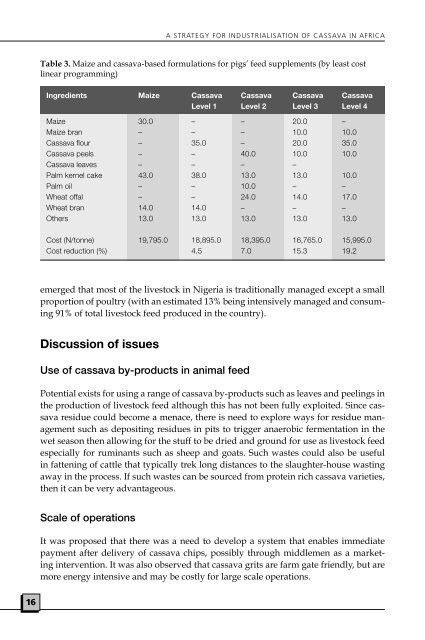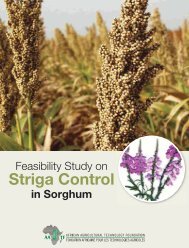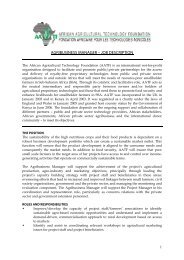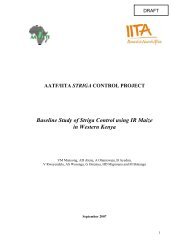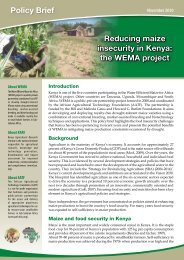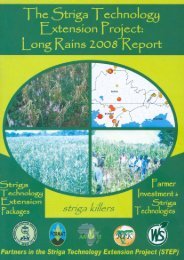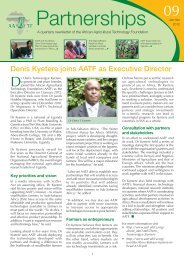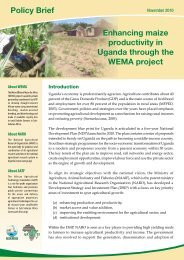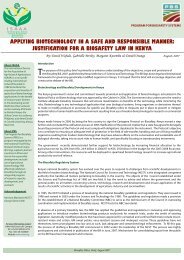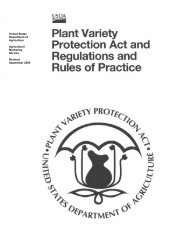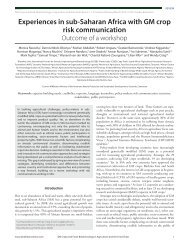A strategy for industrialisation of cassava in Africa - African ...
A strategy for industrialisation of cassava in Africa - African ...
A strategy for industrialisation of cassava in Africa - African ...
You also want an ePaper? Increase the reach of your titles
YUMPU automatically turns print PDFs into web optimized ePapers that Google loves.
A STRATEGY FOR INDUSTRIALISATION OF CASSAVA IN AFRICA<br />
Table 3. Maize and <strong>cassava</strong>-based <strong>for</strong>mulations <strong>for</strong> pigs’ feed supplements (by least cost<br />
l<strong>in</strong>ear programm<strong>in</strong>g)<br />
Ingredients Maize Cassava Cassava Cassava Cassava<br />
Level 1 Level 2 Level 3 Level 4<br />
Maize 30.0 – – 20.0 –<br />
Maize bran – – – 10.0 10.0<br />
Cassava flour – 35.0 – 20.0 35.0<br />
Cassava peels – – 40.0 10.0 10.0<br />
Cassava leaves – – – –<br />
Palm kernel cake 43.0 38.0 13.0 13.0 10.0<br />
Palm oil – – 10.0 – –<br />
Wheat <strong>of</strong>fal – – 24.0 14.0 17.0<br />
Wheat bran 14.0 14.0 – – –<br />
Others 13.0 13.0 13.0 13.0 13.0<br />
Cost (N/tonne) 19,795.0 18,895.0 18,395.0 16,765.0 15,995.0<br />
Cost reduction (%) 4.5 7.0 15.3 19.2<br />
emerged that most <strong>of</strong> the livestock <strong>in</strong> Nigeria is traditionally managed except a small<br />
proportion <strong>of</strong> poultry (with an estimated 13% be<strong>in</strong>g <strong>in</strong>tensively managed and consum<strong>in</strong>g<br />
91% <strong>of</strong> total livestock feed produced <strong>in</strong> the country).<br />
Discussion <strong>of</strong> issues<br />
Use <strong>of</strong> <strong>cassava</strong> by-products <strong>in</strong> animal feed<br />
Potential exists <strong>for</strong> us<strong>in</strong>g a range <strong>of</strong> <strong>cassava</strong> by-products such as leaves and peel<strong>in</strong>gs <strong>in</strong><br />
the production <strong>of</strong> livestock feed although this has not been fully exploited. S<strong>in</strong>ce <strong>cassava</strong><br />
residue could become a menace, there is need to explore ways <strong>for</strong> residue management<br />
such as deposit<strong>in</strong>g residues <strong>in</strong> pits to trigger anaerobic fermentation <strong>in</strong> the<br />
wet season then allow<strong>in</strong>g <strong>for</strong> the stuff to be dried and ground <strong>for</strong> use as livestock feed<br />
especially <strong>for</strong> rum<strong>in</strong>ants such as sheep and goats. Such wastes could also be useful<br />
<strong>in</strong> fatten<strong>in</strong>g <strong>of</strong> cattle that typically trek long distances to the slaughter-house wast<strong>in</strong>g<br />
away <strong>in</strong> the process. If such wastes can be sourced from prote<strong>in</strong> rich <strong>cassava</strong> varieties,<br />
then it can be very advantageous.<br />
Scale <strong>of</strong> operations<br />
It was proposed that there was a need to develop a system that enables immediate<br />
payment after delivery <strong>of</strong> <strong>cassava</strong> chips, possibly through middlemen as a market<strong>in</strong>g<br />
<strong>in</strong>tervention. It was also observed that <strong>cassava</strong> grits are farm gate friendly, but are<br />
more energy <strong>in</strong>tensive and may be costly <strong>for</strong> large scale operations.<br />
16


